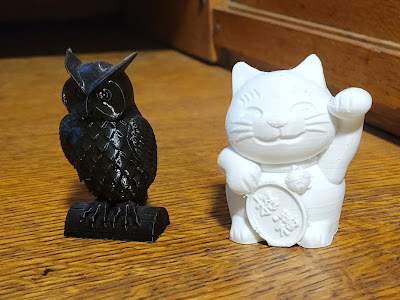Of course, the printer is just the starting point: at the very least, I will also need filament. 3D printer filament closely resembles weed whacker line, but is more specialized in chemical makeup. While there are several different types of filament available, PLA+ seems to be the most common for general printing these days. My go-to online source for filament is IIIDMax; they run sales fairly regularly and offer a bewildering array of colors.
Once you have a printer and filament, the next thing needed is a design. This is a file of coordinates and layer details needed to create the print. Most printers will come with a few test print files for calibration purposes.
Probably the most widely used source of 3D printer files is Thingiverse. Files are available at no charge for makers to download and use, and there is a donation option for those who wish to offer financial thanks for a particular design. Another resource for 3D printer files is a website called Thangs.
There are designs for just about anything imaginable. For a few prepper related examples, here are files for:
- a can dispenser which is scalable for anything from soda cans and larger
- a water tap that can be used with a variety of containers
- a screw lock carabiner for attaching things to our load bearing equipment
- a tarp gripper
- a multipurpose bag clip
Once a design has been acquired, it needs to be rendered from the initial stl file format to a format the printer can work with. The Ender 3 V2 uses GCode files, and one of the more commonly used programs for this is Ultimaker Cura. It not only renders files for printing but also allows us to make changes to things like quality, scale, and orientation of the model.
For those who want to try their hand at creating their own
design, Tinkercad is a free online
design program. There is a learning curve, but users can fairly quickly make
objects for printing. The hardest part with this program for me so far has been
learning to think in millimeters.
Over the weekend I printed out the first design that was truly mine from concept to print. It’s a magnetic doorstop sized to take standard 18mm magnets. It’s not perfect, and I’m already planning version 2, but overall I’m pretty pleased with the results.
There are a huge number of resources available online to learn more about the art of 3D printing. One that has been recommended to me is Teaching Tech which has both a YouTube Channel as well as a webpage.
As I said at the start of this post, I’m still a beginner in this area, but 3D printing has great potential for preppers to make many small things we need for ourselves and our community.




A mechanic friend picked up a 3d printer, he uses it to print various small car parts that are incredibly overpriced from the manufacturer (sun visor clips are something that he makes fairly often).
ReplyDeleteI have two printers, but haven't had the time to play with them for a while. Let me know if you have questions, I have sources for troubleshooting and supplies.
ReplyDelete